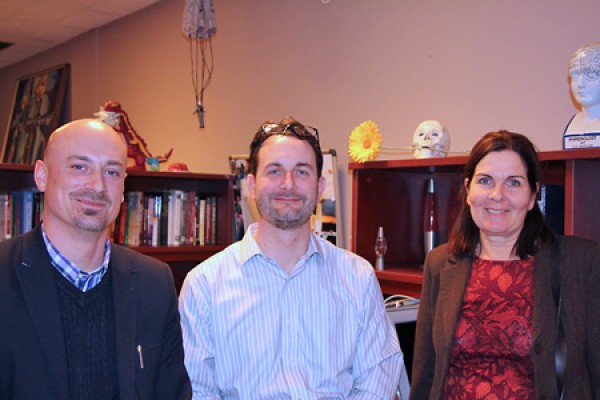 Psychology professors Christopher Abeare, Alan Scoboria and Lori Buchanan received a $75,000 grant for a machine that measures brain activity.
Psychology professors Christopher Abeare, Alan Scoboria and Lori Buchanan received a $75,000 grant for a machine that measures brain activity.
A high-tech tool on its way to the University of Windsor will help three psychology researchers understand how we use our brains to communicate with others, remember past experiences, and recovery from brain injury.
A Canada Foundation for Innovation grant will purchase a portable neuroimaging machine that measures brain activity. It’s called a functional near-infrared spectroscopy, or fNIRS.
“These infrastructure grants are about bringing in equipment that allows new types of collaboration and research, that couldn’t happen otherwise,” said project leader Alan Scoboria.
Christopher Abeare, associate professor in clinical psychology and director of the UWindsor Sport Concussion Clinic, specializes in studying varsity athletes’ brains, as well as their behaviour both before and after brain injury from concussions.
Dr. Abeare says the fNIRS shoots infrared light into the head and catches the reflections back. This allows him to determine changes in blood flow to various regions of the brain. Abeare says the fNIRS is relatively inexpensive compared to other neuroimaging systems and its portability gives it a major advantage.
“The nice thing is you don’t have to be lying down inside of a magnet, so people can engage in real world tasks,” he said. “This has always been a major problem with standard neuroimaging research. It’s a big leap from what a normal person does on their back in a scanner, versus what they do in the real world or in a lab doing various tasks.”
Psychology professor Lori Buchanan, a former Canada Research Chair in Psycholinguistics, studies the reading abilities of people who have suffered brain injury from stroke. She monitors their ability to read and process a single printed word, and compares that to how normal university aged people process a written word.
“On the one hand, it helps us understand how people process words in general,” said Dr. Buchanan. “And on the other hand, we might be moving towards ways of helping these patients recover some of their language function.”
Buchanan’s lab will also be getting an eye-tracking machine that will allow her to see where people are looking when they are reading. She’ll use the eye-tracking machine along with the fNIRS and the electroencephalography (EEG) that her lab already uses.
EEG measures the brain’s electrical activity and it’s the electrical activity that stimulates the brain’s blood flow. If the process is interrupted by injury, it can prolong recovery. The three tools combined will help build a more complete picture of what happens when the brain suffers from injury.
Scoboria is an associate professor in the Department of Psychology. His research revolves around perceived human memory and the components of remembering. He says he wants to understand how we decide to label something that comes into our brain, as something that actually happened in our past.
“Most of the time we assume that what we remember is both true and accurate,” said Scoboria. “What I’ve been studying is where that breaks down.”
He says the fNIRS will help measure the distinct aspects of believing, remembering and recollection in much more reliable ways than typical psychological ways. The technology will help explain the neurology that underlines social remembering.
The $75,000 grant will help all three UWindsor researchers establish a facility for cognitive neuroscience in acquired brain injury.
For more information on fNIRS and the facility for cognitive neuroscience in acquired brain injury, tune into CJAM radio’s Research Matters, Wednesday, February 4, on 99.1FM at 4:30 p.m. Host Sara Elliott will chat in-depth with Abeare.
